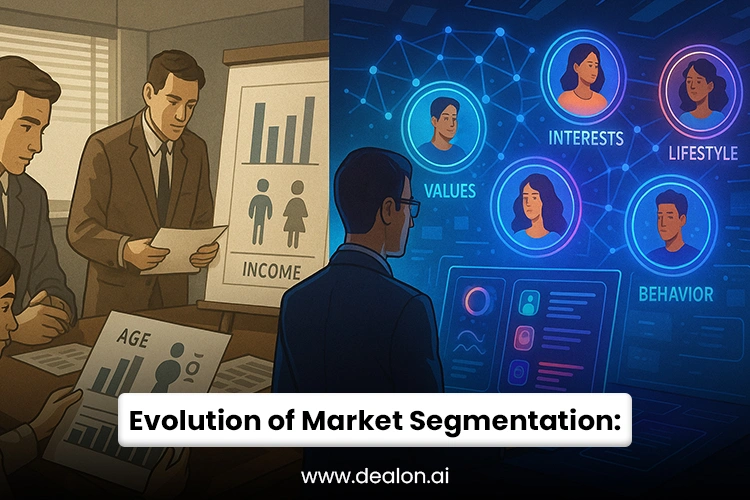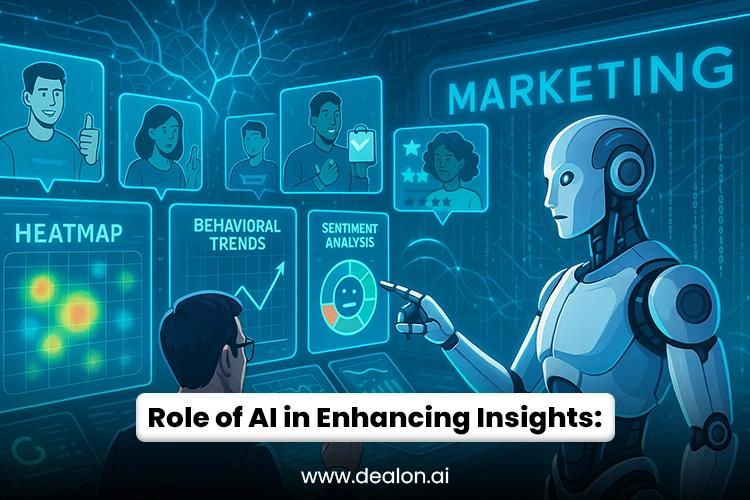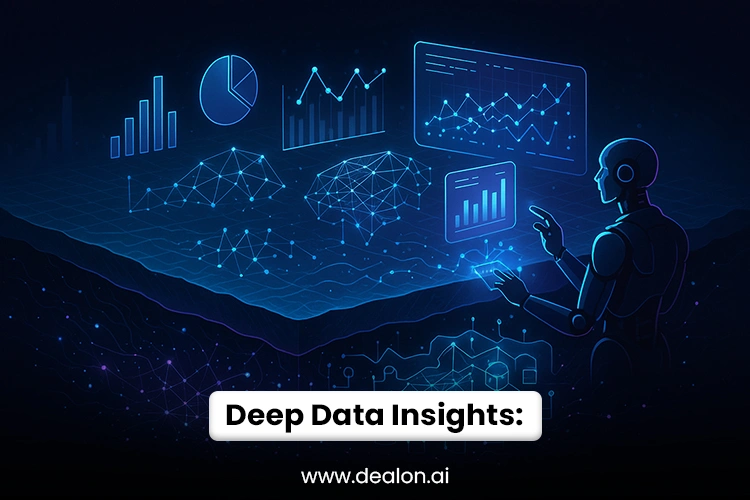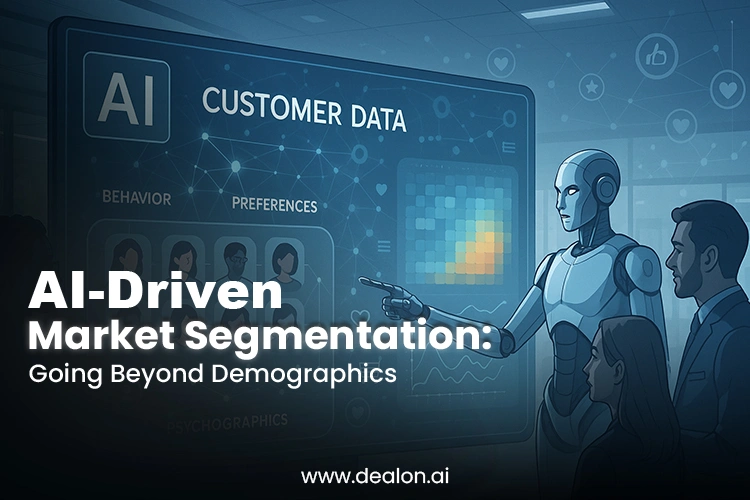Amid the transforming of the digital industry, there has been a decline in the use of demographic information as the traditional mechanism of market segmentation. As digital transformation is a process that will not end, the techniques employed to guide digital advance should also change. The arrival of AI marks a turning point in how companies deal with market segmentation as it changes the face of it. The enormous data that AI can handle allows businesses to go beyond the primary categories applied in traditional segmentation and the processed data.
The use of AI in processing and mining recent data enables businesses to deliver the highest degree of personalization, making market segmentation more complex and flexible. This methodology allows companies to manage marketing approaches that readily adapt to evolving consumer trends. It is increasingly evident that segmenting markets is transitioning from basic demographic approaches to a more precise appreciation of distinctive consumer traits, allowing firms to forecast future requirements and supply exact solutions. Since data has become the centerpiece of the contemporary business, using AI becomes imperative for companies striving to keep the competitive edge and avoid falling behind.
Also Read: Deepfake Dilemma: Navigating the Ethical Minefield of AI-Powered Media Manipulation
The Evolution of Market Segmentation: From Demographics to Psychographics

The old days are gone; the landscape of market segmentation has transformed dramatically, from generalized demographic portraits to a detailed and AI-supported system capable of maximizing complex consumer interests. Previously, market segmentation practices heavily relied on simple characteristics like age, sex, income, educational qualification, etc. Despite their importance, these methods do not fully outline the many elements that shape buyer decisions. Hence, firms often base their audience targeting on limited data. Segmentation strategies based solely on simple categories like age and income failed to investigate deeper motivations behind people’s choices.
AI-driven segmentation techniques enable firms to eliminate the narrow advantages of a limited demographic analysis and instead provide a comprehensive palette of psychographics and behaviors by combining large data sets. With the help of psychographics, which involves individual interests, lifestyle, values, and attitudes, businesses receive a more marked understanding of what motivates the target audience’s behavior. Demographics tell us ‘who’ the person is (the surface), and psychographics reveal the ‘why’ underneath current product and service purchase (the heat), allowing for a more accurate and appropriate segmentation.
Analyzing such rapidly changing data points allows businesses to learn about consumers’ past behavior and weigh in on future consumer action trends. By applying machine learning, AI can analyze vast amounts of data within seconds, updating consumer groupings to be in tune with continual changes in their behavior. By doing this, the businesses can provide personalized experiences beyond segmentation. With marketing strategies, they are then able to ensure precision-tailored strategies.
The Role of AI in Enhancing Insights into Customer Behavior in the Future

The use of AI is influencing the understanding of consumers’ behavior in business in such a way that companies can now effectively pull off market segmentation goals impossible to achieve earlier. Machine learning algorithms can process and analyse enormous and complicated data sets, discarded by humans in the older techniques, which are too voluminous in number to be parsed by humans, extracting meaningful insights out of the depths of the data. These gains have implications for understanding previous preferences and constructing strategies that impact future consumer actions. From AI’s ongoing ability to improve upon its segmentation criteria to its ability to provide real-time, predictive, and personalized personalization capabilities, AI stands itself against conventional methods.
Real-time segmentation is one of the substantial advantages of the application of AI on market segmentation. On the other hand, traditional segmentation might be slide-based. At the same time, AI algorithms would constantly analyze incoming data to allow businesses to adjust their targeting strategies over time as the changing situation dictates. AI updates segmentation dynamically due to changing consumer behaviours caused by seasonal change, leading trends, or even unanticipated contingencies. By the facility to change and adjust swiftly, businesses relate with their target audience and maximize the effect of their marketing campaigns.
Supported by AI, predictive segmentation provides an improved market analysis by accurately predicting upcoming trends in consumer behavior. Using predictive analytics based on past data, AI can determine patterns in purchasing habits, content interest, and future ties to a brand. Consequently, firms can make marketing plans in advance and not react to the day’s conditions. For instance, AI can determine that a consumer intends to purchase a specific product next month by using the historical engagement data of the customer. As a result, firms can create tailored marketing materials that considerably strengthen conversion outcomes.
Comprehensive awareness of impending and actual shifts in demand, combined with correctly predicted evolutions in customer behavior, allows companies to allocate resources effectively and make their campaigns more efficient. AI also supports executing personalized initiatives, outperforming the basic categories firms traditionally apply in market segmentation. Companies can now use AI to develop individualized approaches that correspond directly to each customer’s habits, preferences, and actions. Such targeted approaches enable the brands to serve the content and suggestions thatmore relevant to the consumers, hence a better engagement and conversion rates. AI technologies allow businesses to recommend products based on browsing habits, social media activity, and whether n a consumer is most likely to consume digital content.
Yet, by incorporating these advanced AI methods into its segmentation strategy, any business can effectively enhance its individualized, fast, and targeted approach for interacting with its audience. This means increased conversion rates and improved customer loyalty as consumers see brands as more attentive and valuable as they respond precisely to what each person wants. Under the current data-driven marketing span, AI is not a resource but an influential force dictating the strategy and results.
Deep Data Insights: Going Beyond the Surface

The capability of AI to analyze and interpret vast amounts of complicated data is reshaping the marketplace segmentation that enables companies to discover deep and actionable truths regarding consumer behavior. Besides generic demographics profiles, AI allows using refined and complex data to give enterprises a highly detailed view of their target markets. With access to complex datasets, AI exposes consumer behaviour and trends previously unseen. Sentiment analysis, location-based data, and temporal segmentation are critical driving data types for business growth.
Using sentiment analysis, AI can differentiate and quantify the resonance of emotions conveyed through content generated by consumers. AI can detect such sentiments as positivity, negativity, or neutrality by examining the linguistic patterns involved in customer communications. Through utilizing such emotional awareness, enterprises are in a position to change messaging, style, as well as overall strategy based on consumer sentiment. For instance, if a rise in negative sentiments surrounding a product is noted through sentiment analysis, organizations can take quick measures to address issues, offer solutions, or adjust their marketing angle to improve the brand’s reputation. Learning about emotional factors acting on the consumer’s actions, we make the audience engagement strategies of the companies more precise.
Location-based segmentation is another significant development in AI where a geographic database is interrogated to derive patterns in consumer behaviour state or very localized level. AI can make sense of location-specific data, such as GPS, search activity tied to geography, store visitors, etc., to reveal details that can be used to create customized marketing campaigns. For example, a company might discover that specific products are successful in cities but are not very attractive in rural areas.
The opposite is true in that people living in colder regions of the world were also likely to show enhanced interest toward the products designed for their climate, than those living in hotter climates would show. Using location-based segmentation, firms can craft slogans, promotions, and products that appeal to their regional audience, thus increasing relevance and sales.
Using the temporal trends, the temporal segmentation provides great insights about how consumers behave at different times. Machine learning data assists businesses in understanding the best time to push for engagement with brands, shopping, or even productive interest in brands. With AI, companies can realize some consumer types are most connected to products after hours, or that other specific segments are predisposed to purchase at critical points such as holidays and during back-to-school times. Temporal data helps businesses time the delivery of their promotions, product launches, and content in correspondence with consumer exposure troughs, increasing their impact. Brands can then use such knowledge of consumer behaviour patterns to create targeted messages that happen opportunistically, increasing chances of conversion.
These innovative strategies expose the enormous potential of AI in providing multi-layered, rich data that no other traditional methods can provide. Companies can reach individuals highly individualized and efficiently using sentiment analysis techniques, location-based, and temporal segmentation. Via AI, firms can penetrate the vested interests of consumer behavior, fine-tune their strategies, cultivate closer bonds with their target groups, and stay ahead in the dynamic market environment.
How Advanced technologies influence improved Customer Interactions.
Artificial Intelligence (AI) has profoundly changed how companies interact with customers, mainly by improving ways of segmentation. Improving customer connections, AI enables the provision of personalized content and products to create a more customer-meaningful experience. A customized strategy enhances marketing relevance and continuous interaction, creates long-term loyalty among customers, and brings higher conversion rates – essential components of successful businesses.
Enhanced consumer interaction emerges as an essential early success from AI-powered segmentation techniques. Danai Mrhe allows the organization to handle lots of data, making it possible to observe and act on individual customer behaviors through personalized suggestions. For example, the online shopping site can present recommendations for products that customers previously looked at (to show them), while the video streaming service can offer such a list of shows (based on aspects of what viewers had previously chose). Tweaking the content to suit each customer’s genuine interest greatly increases the prospects for a fruitful interaction. Interactivity and reciprocity between brand and consumer are enhanced when consumers feel personally relevant to marketing communications.
Additionally, AI becomes crucial in improving customer loyalty by engaging them more. With the brands increasingly giving customized and valuable experiences, more and more consumers are likely to engage with the brand on an emotional level. AI helps companies follow and adapt to changes in consumer tastes in real-time. Such adaptation is a continuous process through which brands can adjust to customers’ changing demands, hence critical to building sustainable loyalty. An example is if a subscription service adapts its recommendations in real time along with the customer’s current behaviour, making the customer feel valued. Despite the highly personalized experience that businesses offer, they gain trust from their customers to the point that they encourage loyalty and regrowth.
Besides, the AI-driven segmentation automatically implies the growth of conversion rates. AI helps businesses extend to the right consumers with personalised messages at the right time. Traditionally, marketing depends on a general campaign, which addresses a lot of prospects in the hope some will convert; AI gives more power to a much more targeted approach. By analyzing web traffic, intent, and social interest, AI allows brands to zero in on the most responsive consumers and direct ads or incentives targeting their interests or goals. With this targeted approach, marketing results are magnified and company resources can be used smartly, thus cutting needless expenditure and maximizing returns on investment.
The gains from AI-driven market segmentation are not those of operations; insteadthey are foundational for the customer experience as a whole. AI is essential in customer engagement, loyalty, and conversions, which helps organizations make more forceful client engagements. As AI progresses, it will become increasingly critical for businesses to establish even more personalized customer experiences to survive in the cutthroat, customer-oriented environment.
Ethics of AI Use in Market Segmentation
With AI being incorporated into market segmentation, the vast data analysis abilities have created immense business opportunities. However, introducing these technologies entails serious ethical concerns that primarily regard privacy, data security, and the potential for manipulation.
Oppenheimer establishes the ethical foundations of the management of data. Consumers need to be informed clearly on what data is collected, how it will be used, and why they are collected in the first place. Open and straightforward policies reduce customers’ scepticism about the company. Customers can control the handling of their data regarding which forms of data co-sharing they want to give or withhold in the face of transparency. Consumers are more inclined to trust brands when they understand what data is being collected and have control over how their data is utilized.
Consumer data protection is as essential as ethical market segmentation. Advanced algorithms might manage personal information such as consumer selections, activity, and buying habits. Organizations are mandated to maintain very high levels of security to protect the privacy and safety of critical information from breach and misuse. Such steps include encryption, secure storage methods, and regular audits to guarantee compliance with international data protection rules. Consumers must believe that their data is secured not only with care but also with principle.
Companies should avoid the consequential harmful or deceptive tactics paid for by segmentation efforts. It is a risk that AI algorithms can exploit the vulnerabilities of consumers to use misleading tactics or exploit insecurities to create dependency or promote products that may not genuinely work to the benefit of the person. Segmentation that exceeds limits threatens to bring about discriminatory results, unjustly categorize groups, or intensify prejudicial presumptions. Companies must regularly check segmentation methodologies to promote inclusiveness and destroy exclusive notions and practices that can harm or penalize a particular group.
Conclusion
Companies are now wondering at the unprecedented data they are getting regarding their customers, thanks to the use of AI in segmentation. Using AI, marketers can move beyond the traditional demographics and use psychographics, the behaviors of the customers, and top data analysis to create very specific, relevant, and dynamic marketing plans. AI performs great by immediately responding to the actions of consumers, creating personalized content, making correct predictions, and providing a personally insightful portrait of interests.
To consider the enormous benefits they bring to customers’ experiebusinesses must take an ethical approach to AI adoption. Yoking data to be treated transparently, privacy to be guarded with strong protections, and fairness to be valued are at businesses’ must makeation to cross the line into invading consumer privacy or delivering unfair results. Finding a compromise between technological advancement and ethics helps companies acquire confidence, refresh client alliances, and produce a favorable lustre in the market.

